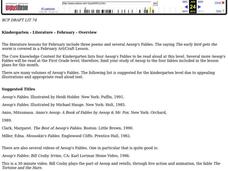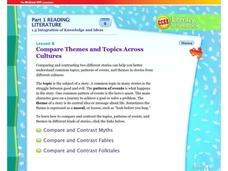August House
The Contest Between the Sun and the Wind
Learn the moral of the story with a series of activities about Aesop's fables. Focusing on The Contest Between the Sun and the Wind, learners complete a graphic organizer to discuss who, what, how, and why the events occur. Additionally,...
Curated OER
Writing a Fable
Students recognize the elements of a fable. In this fable writing instructional activity, students listen to fables and discuss the elements. Students write an original fable.
August House
The Hidden Feast
What is a proverb? This is the leading question of this resource. First, explore proverbs and their meanings. Then, read aloud The Hidden Feast: A Folktale from the American South by Martha Hamilton and Mitch Weiss and partake...
K5 Learning
The Blind Men and the Elephant
Sometimes it's necessary to view the whole picture before making a judgment about a small part. Read a short story about five blind men who try to identify an elephant by feeling different parts and coming to their own conclusions....
Scholastic
Folk and Fairy Tale Readers: The Three Little Pigs
Engage young learners in developing their reading fluency with their very own copy of The Three Little Pigs. Including a series fun illustrations, children will have a hard time putting this book down.
Curated OER
Folktales
A brief list of folktales is displayed on these slides. Four types are written out with an example for each fairytale, tall tale, fable, and trickster tale. The last slides segues into the creator's favorite fairytale, "Two of...
Curated OER
Aesop's Fables
Students read a fable about a lion and a mouse. They discuss the differences between the two animals. As a class, they discover the lesson of the story. Then they make puppets and reenact the fable.
Curated OER
Pop Up Fables
Students read a fable and create a pop-up book of the fable. Students add the moral of the story to the back of the book.
Curated OER
Fables With Dolch Sight Words
Second graders read classic fables, consider their meaning and then re-write them using a prompt if necessary. This lesson plan presents many classic fables that students can read, and re-write, using their powers of imagination.
Curated OER
Fables
In this fables worksheet, students learn about the different parts of a fable. They learn how to retell a story, analyze the characters, identify the moral and dramatize the story.
Curated OER
Folktales: Fables
Learners access a variety of resources on the Internet regarding folktales, fables, tall tales, and fairy tales. They read and compare/contrast the elements of fables, and complete various handouts.
Curated OER
Aesop’s Fables Comparison Worksheet
In this Aesop's Fables comparison activity, students list the name of the fable, its characters, a story summary, and the moral of the story. They compare 6 fables.
Curated OER
Fearless Fables: Wee Little Chick And the Magic Apron
In this reading worksheet, students investigate the fable form of storytelling by reading a 3 page fable about a chick who is being bullied. There are no questions on this worksheet.
Curated OER
Fearless Fables: The Moon in Mill Pond
In this reading comprehension worksheet, students participate in reading a fable about some animals who lacked good sense. There are no questions about the story on this page.
Curated OER
The Fable of Franny And Her Fabulous Fainting Goat
Mix the art of reading comprehension with the skill of telling time. Children in grades two and three will discuss the importance of goats throughout history based on the provided background information. They'll create cute goat...
Curated OER
Fable of the Fainting Goat
Second graders explore animal life by reading children stories in class. In this goat fable lesson, 2nd graders read several books which describe the different myths and folklore about goats. Students identify the needs of living animals...
Read Works
The Boy Who Cried Wolf
Reinforce reading comprehension strategies and contemplate an important life lesson with a learning exercise featuring Aesop's fable, The Boy Who Cried Wolf. After reading a brief passage, scholars show what they know by...
McGraw Hill
Compare Themes and Topics Across Cultures
Compare and contrast folktales, myths, and fables in an interactive eBook. The interactive is broken up into three topics: myths, fables, and folktales. Each section includes a reading passage and a guided lesson on the theme, topic, and...
Fluence Learning
Writing an Opinion: Is Pride Good or Bad?
Does pride really goeth before the fall, or can it be essential to one's development? Second graders read two of Aesop's fables that refer to pride in their morals, and write a short essay about whether pride is good or bad, based on...
Great Books Foundation
The Fox and the Stork
Young readers take part in a meaningful discussion following a reading of Aesop's fable "The Fox and the Stork." Five questions focus on the characters' actions and offering apologies.
Curated OER
Deciding Theme
Read aloud to your class the fable "The Lion and the Mouse" as you explore characters' choices and the effects they have on a story. Apply what is discussed to finding a theme of the chapter "Not Giving Up" from The Wizard of...
K20 LEARN
Here's How I Heard It: Using Folklore To Improve Close Reading Skills
"X" is for exaggeration, and "F" is for fact. To encourage close reading and to improve literary analysis skills, class members annotate fables and tall tales, like Paul Bunyan, with symbols that identify key features of this genre.
Nemours KidsHealth
Self-Esteem: Grades 3-5
Two lessons examine self-esteem and encourage scholars to exude confidence. Lesson one asks learners to recognize the characteristics of self-esteem then create a collage compiled of images that reflect their skills, accomplishments, and...
Overcoming Obstacles
Cooperation and Teamwork
One of Aesop's fables begins with a lesson plan about cooperation and teamwork. Scholars listen carefully, taking note of the moral of the story. The class discusses their findings and why working with others makes work easier. Learners...
Other popular searches
- Writing Fables
- Morals Fables
- Aesop's Fables
- Characteristics of Fables
- Fables and Fairy Tales
- Aesops Fables
- Myths Fables
- Aesop Fables
- Lesson Plans on Fables
- Fable Story Elements
- Compare Contrast Myth Fable
- Reader's Theater Fable

























